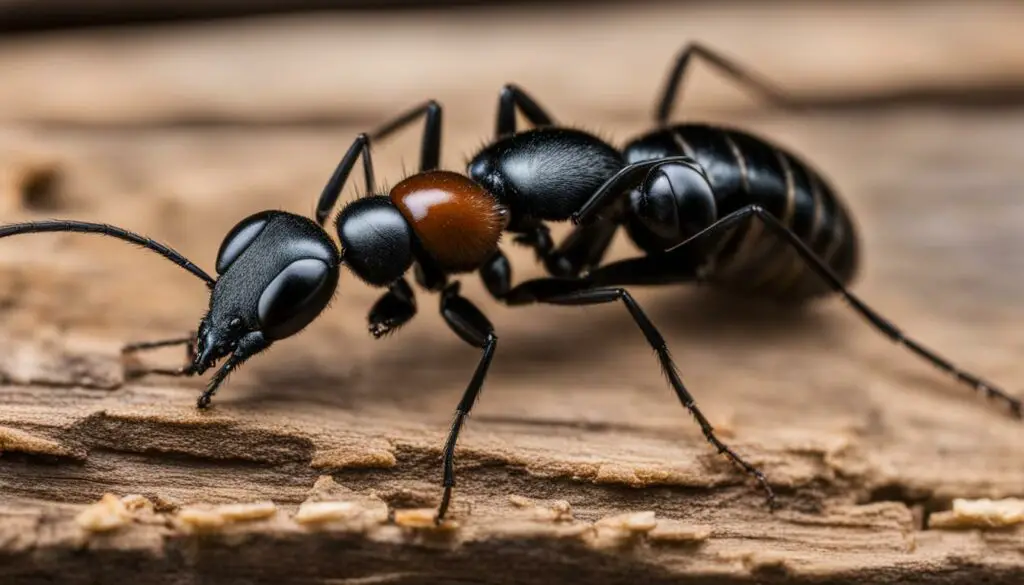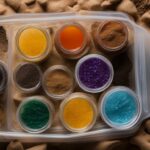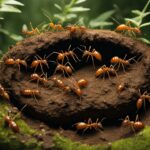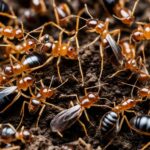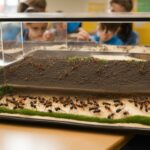Welcome to my comprehensive guide on Carpenter ant pet care. If you’re considering keeping Carpenter ants as pets, it’s essential to understand their behavior, habitat, diet, and the proper setup for their enclosure. In this guide, I will provide expert tips and advice to ensure you can give your Carpenter ants the best care possible.
Key Takeaways:
- Understanding Carpenter ant behavior is crucial for providing appropriate care as pets.
- Creating a habitat that mimics their natural environment is essential for their well-being.
- Feeding Carpenter ants a balanced diet of protein and carbohydrates is important for their nutrition.
- Regular monitoring, cleaning, and maintenance of the enclosure are necessary for their health.
- Handling Carpenter ants with care is essential to prevent injury to both you and the ants.
Understanding Carpenter Ant Behavior
When it comes to caring for Carpenter ants as pets, a key aspect is understanding their behavior. Carpenter ants are social insects that live in large colonies, known for tunneling through wood to create nests. They are diurnal creatures, meaning they are active during the day and sleep at night. Carpenter ants communicate through the use of pheromones, leaving scent trails to navigate and find food sources. They are primarily omnivorous, feeding on a variety of foods including insects, fruits, and sweets.
By understanding their behavior, you can provide appropriate care for Carpenter ants as pets. This includes creating a suitable habitat that mimics their natural environment, ensuring a proper enclosure setup with a combination of dry and moist areas. It is also important to provide a balanced diet that meets their nutritional needs. Observing their behavior and activity levels is crucial for maintaining their health and wellbeing.
Additionally, it is worth noting that Carpenter ants can be territorial and may bite if they feel threatened. It is important to handle them with care to prevent any injury to both you and the ants. By understanding their behavior and providing appropriate care, you can create a thriving colony of Carpenter ants as pets.
Summary
- Carpenter ants are social insects that live in large colonies and tunnel through wood to create nests.
- They are diurnal and communicate using pheromones and scent trails.
- Carpenter ants are primarily omnivorous, feeding on insects, fruits, and sweets.
- Understanding their behavior is important for providing appropriate care and creating a suitable habitat.
- Carpenter ants can be territorial and may bite if they feel threatened, so handling them with care is essential.
| Behavior Traits | Description |
|---|---|
| Diurnal | Active during the day and sleep at night |
| Communication | Use pheromones and scent trails to navigate and find food sources |
| Diet | Omnivorous, feeding on insects, fruits, and sweets |
| Territorial | May bite if they feel threatened |
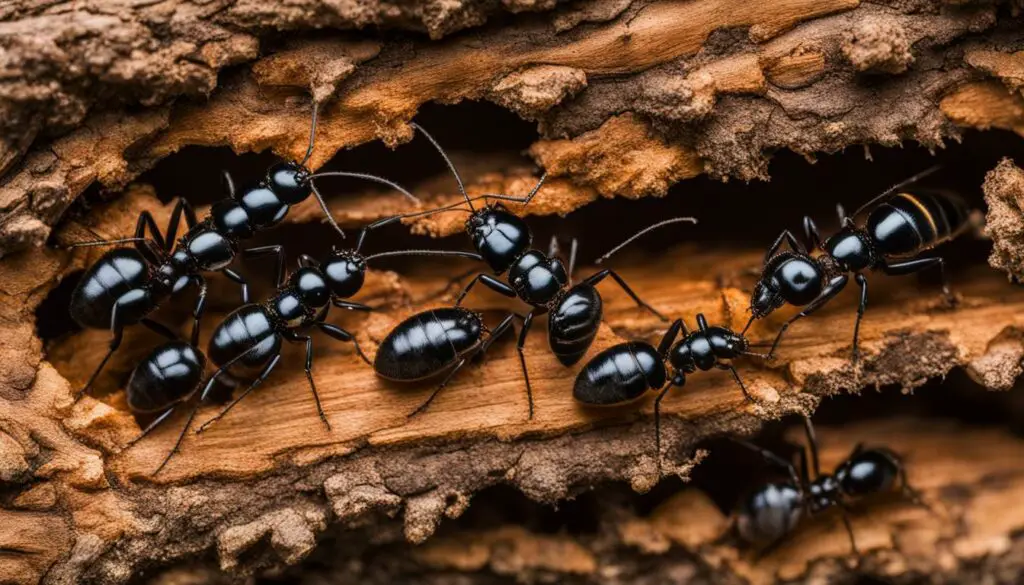
By understanding their behavior and providing appropriate care, you can create a thriving colony of Carpenter ants as pets.
Creating a Carpenter Ant Habitat
When setting up a habitat for Carpenter ants, it is important to create an environment that closely mimics their natural habitat. This will not only ensure their physical well-being but also promote their natural behavior and overall welfare.
The ideal Carpenter ant enclosure setup should include a glass or plastic terrarium with ventilation holes to provide adequate airflow. The enclosure should have a combination of dry and moist areas to cater to the Carpenter ants’ preference for a humid environment. You can achieve this by providing a substrate of soil or sand, which can be slightly dampened, and adding natural materials like wood and leaves for tunneling and nesting.
It is crucial to regularly clean and maintain the habitat to prevent the build-up of waste and mold. This can be done by removing uneaten food, cleaning any debris or waste, and ensuring that the enclosure remains hygienic. Regular monitoring of temperature and humidity levels is also important to ensure that the Carpenter ants are kept in optimal conditions.
| Essential Requirements for Carpenter Ant Habitat | Recommended Options |
|---|---|
| Enclosure Type | Glass or plastic terrarium with ventilation holes |
| Substrate | Soil or sand |
| Natural Materials | Wood, leaves |
| Temperature | 70°F to 80°F (21°C to 27°C) |
| Humidity | 50% to 70% |
By providing a suitable habitat for Carpenter ants, you can ensure their well-being and create an engaging environment for observation and study. It is important to remember that Carpenter ants are complex creatures with specific needs, and taking the time to understand and cater to those needs will lead to a successful and rewarding experience as a Carpenter ant owner.
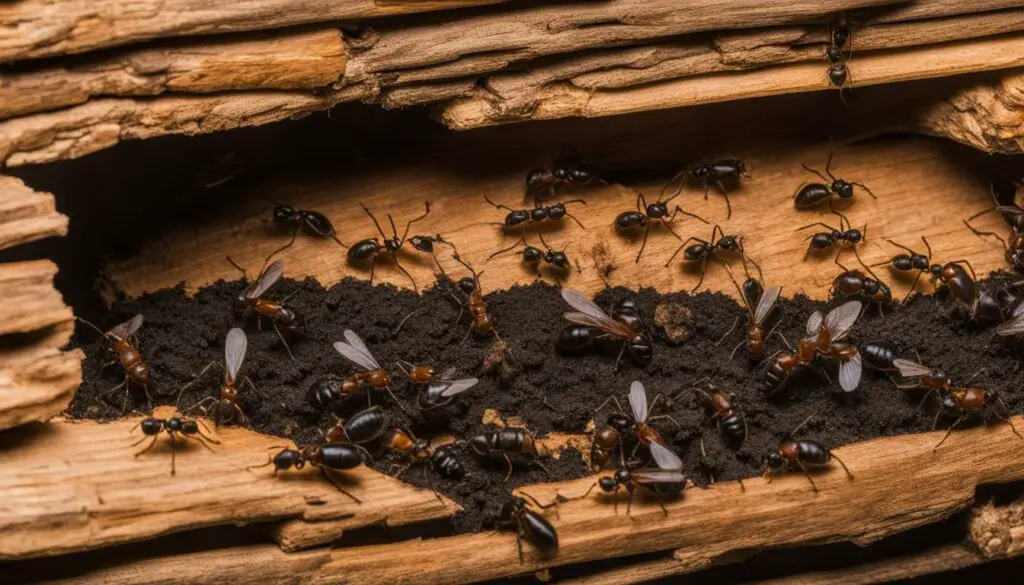
Feeding Carpenter Ants
Feeding Carpenter ants as pets requires providing them with a balanced diet that meets their nutritional needs. They are omnivorous insects that consume a variety of foods, including insects, fruits, and sugary liquids. To ensure their health and wellbeing, it is important to offer a combination of protein and carbohydrates in their diet.
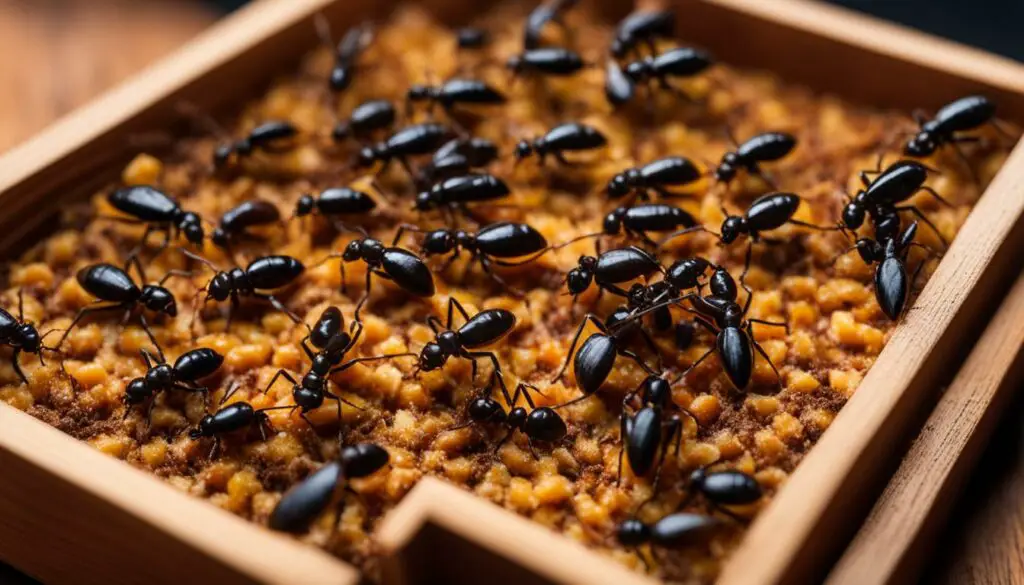
When feeding Carpenter ants, you can provide them with small insects like fruit flies or crickets as a source of protein. These can be purchased from pet stores or bred at home using fruit fly culture kits or cricket breeding setups. It is important to offer live or freshly killed insects, as Carpenter ants are more likely to recognize and consume them.
In addition to insects, fruits can be included in their diet. You can offer small pieces of ripe fruit such as grapes or berries. These not only provide a source of carbohydrates but also serve as a source of hydration for the ants. It is important to avoid using citrus fruits, as the acidity can be harmful to Carpenter ants.
To satisfy their sweet tooth, Carpenter ants can be provided with sugary liquids. This can include a mixture of honey and water or sugar water. These should be offered in small amounts, as excess sugar can lead to health issues such as obesity and dental problems in ants.
Feeding Carpenter Ants: Tips and Precautions
When feeding Carpenter ants, it is important to keep a few tips and precautions in mind. First, it is recommended to offer food in small amounts to prevent wastage and the growth of mold. Remove any uneaten food after a few hours to maintain a clean environment.
Second, it is important to avoid feeding Carpenter ants foods that are toxic to ants. This includes citrus fruits, as mentioned earlier, as well as foods containing artificial sweeteners such as xylitol or aspartame. These substances can be harmful or even fatal to Carpenter ants.
Lastly, it is essential to maintain a clean feeding area. Regularly clean food dishes or containers to prevent the buildup of bacteria or mold. This helps ensure the overall health and wellbeing of your Carpenter ant colony.
By providing a balanced diet of protein, carbohydrates, and sugary liquids, you can ensure the nutritional needs of your Carpenter ants are met. Remember to monitor their feeding habits and adjust their diet accordingly to promote their overall health and longevity.
Creating the Ideal Carpenter Ant Enclosure Setup
When it comes to creating the ideal Carpenter ant enclosure setup, there are a few essential supplies you’ll need to ensure the comfort and well-being of your ant colony. These supplies include a suitable enclosure, substrate, natural materials for nesting, food dishes, a water source, cleaning supplies, and a temperature and humidity monitor. By providing these items, you can create an environment that closely mimics their natural habitat, promoting their overall health and happiness.
First and foremost, you’ll need a suitable enclosure for your Carpenter ants. This can be a glass or plastic terrarium with proper ventilation holes to allow for airflow. The size of the enclosure will depend on the size of your ant colony and how many ants you plan to house. It’s important to choose an enclosure that provides enough space for the ants to move around comfortably.
Next, you’ll need to provide a substrate for your Carpenter ants. This can be soil or sand, which will help create a natural environment for them to burrow and tunnel. Additionally, you should include natural materials such as pieces of wood or leaves for nesting and building their colonies. These materials will provide the ants with a sense of security and enable them to engage in their natural behaviors.
To ensure your Carpenter ants have access to food and water, it’s essential to include food dishes and a water source in their enclosure. You can use small dishes or containers to offer a variety of foods, including insects, fruits, and sugary liquids. It’s important to provide a balanced diet and regularly monitor the food dishes to remove any uneaten food and prevent mold growth. For the water source, you can use a water gel or a water dispenser that provides a steady supply of moisture.
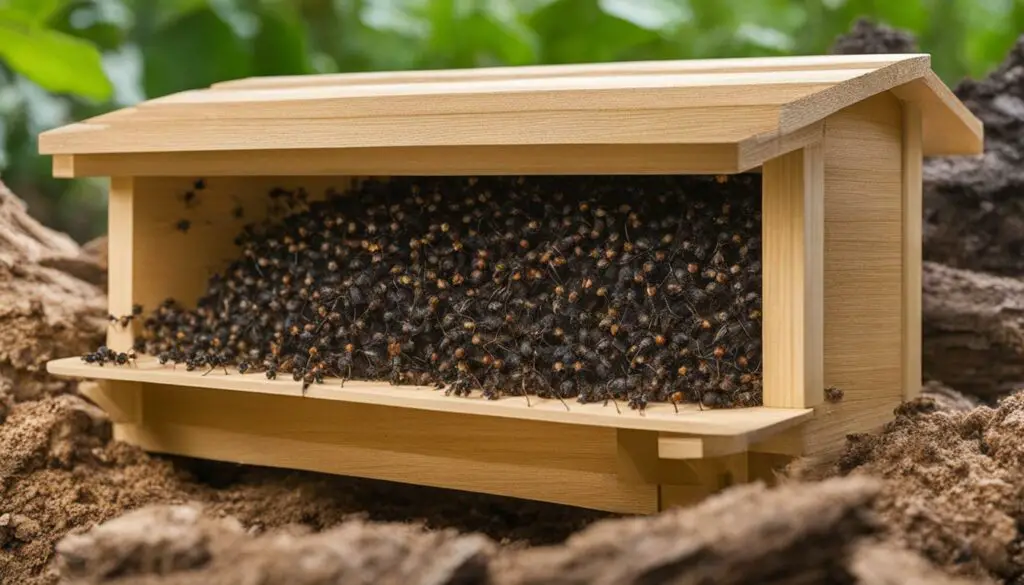
| Essential Supplies for Carpenter Ant Enclosure Setup | Description |
|---|---|
| Enclosure | A glass or plastic terrarium with ventilation holes |
| Substrate | Soil or sand for burrowing and tunneling |
| Natural materials | Pieces of wood or leaves for nesting |
| Food dishes | Small dishes or containers for offering a variety of foods |
| Water source | Water gel or dispenser for providing moisture |
| Cleaning supplies | Small brush or tweezers for maintaining cleanliness |
| Temperature and humidity monitor | To ensure optimal conditions for your ant colony |
Lastly, it’s important to regularly clean and maintain the enclosure to ensure the health and hygiene of your Carpenter ants. This includes removing any uneaten food, cleaning the dishes, and spot cleaning the enclosure as needed. You can use a small brush or tweezers to remove debris and maintain cleanliness. Additionally, it’s crucial to monitor the temperature and humidity levels within the enclosure using a dedicated monitor. Carpenter ants thrive in specific temperature and humidity ranges, so it’s essential to provide optimal conditions for their well-being.
Carpenter Ant Health and Care Tips
When it comes to keeping Carpenter ants as pets, their health and wellbeing should be a top priority. By following these tips, you can ensure that your Carpenter ant colony thrives and remains healthy.
Monitor Behavior and Activity Levels
Regularly observe your Carpenter ants to monitor their behavior and activity levels. Look for any signs of abnormal behavior, such as lethargy, aggression, or lack of appetite. These may indicate that something is wrong with the colony and prompt further investigation or veterinary assistance if needed.
Maintain a Clean Enclosure
A clean and hygienic enclosure is essential for the health of your Carpenter ant colony. Regularly remove any uneaten food, debris, or waste and clean the enclosure with a small brush or tweezers. This will help prevent the growth of mold or bacteria and create a clean and safe environment for your ants to thrive in.
Provide a Balanced Diet
Offer a balanced diet to meet the nutritional needs of your Carpenter ants. Provide a mix of protein and carbohydrates, such as insects, fruits, and sugary liquids. Avoid feeding them foods that are toxic to ants, such as citrus fruits or artificial sweeteners. Feed them in small amounts to prevent mold growth and remove any uneaten food promptly.
| Food Type | Feeding Frequency | Notes |
|---|---|---|
| Insects | 2-3 times a week | Offer a variety of insects like crickets, mealworms, or fruit flies. |
| Fruits | Once a week | Provide small pieces of fruits like berries, melons, or apples. |
| Sugary Liquids | Every other day | Offer diluted honey or sugar water in small amounts. |
Remember to handle Carpenter ants with care to prevent injury to both yourself and the ants. By implementing these health and care tips, you can ensure that your Carpenter ant colony remains happy and healthy as you continue to enjoy their fascinating behavior and presence.
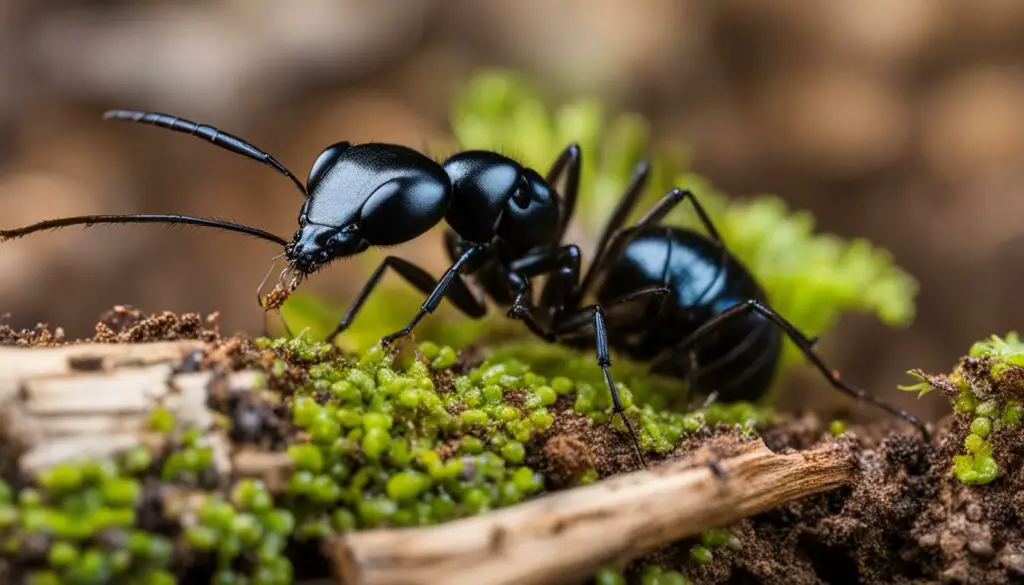
Carpenter Ant Reproduction and Colony Development
Reproduction plays a vital role in the growth and survival of Carpenter ant colonies. These ants have a complex reproductive system and a hierarchical social structure. The queen ant is responsible for laying eggs and starting new colonies. After a mating flight, during which the queen mates with male ants, she sheds her wings and begins to establish a new nest. The queen’s primary focus is reproduction, while the worker ants take on other tasks to maintain and expand the colony. It is fascinating to observe the development of Carpenter ant colonies over time, as new workers and reproductive ants are produced.
To better understand Carpenter ant reproduction, it is helpful to visualize the process through a table:
| Reproductive Role | Description |
|---|---|
| Queen | The queen is the primary reproductive ant in the colony. She lays eggs and establishes new nests. |
| Male Ants | Male ants, also known as drones, are responsible for mating with the queen during a mating flight. |
| Worker Ants | Worker ants are sterile females that perform various tasks to maintain and expand the colony. They do not reproduce. |
As the Carpenter ant colony develops, new workers and reproductive ants are produced. This process can take several years, and the colony gradually grows in size and complexity. It is remarkable to witness the coordination and organization within the colony, with each ant playing a specific role in ensuring its survival and growth.
Carpenter Ant Communication and Social Structure
Understanding the communication and social structure of Carpenter ants is vital for providing appropriate care and ensuring the health and wellbeing of your Carpenter ant colony. Carpenter ants communicate with each other through the use of pheromones and touch, creating a complex network of communication within the colony. They leave scent trails to guide other ants to food sources and coordinate activities.
The social structure of Carpenter ant colonies is hierarchical, with the queen at the top. The queen ant is responsible for reproduction and laying eggs, while the worker ants perform various tasks such as foraging, feeding the young, and maintaining the nest. Each worker ant has its own role within the colony, contributing to the overall functioning and success of the colony.
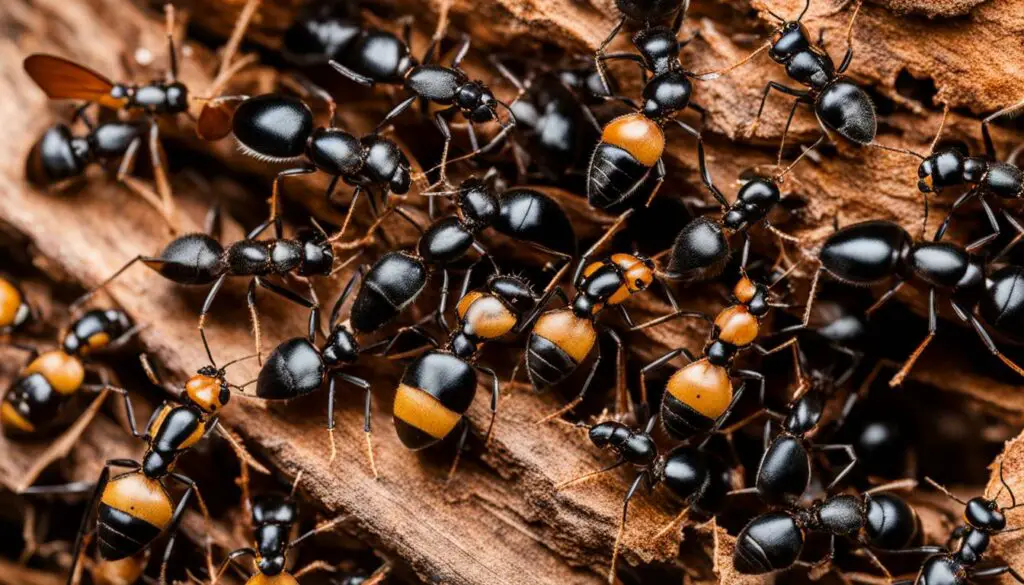
It is fascinating to observe the intricate interactions and cooperation among Carpenter ants as they work together to ensure the survival of their colony. By understanding their communication methods and social structure, you can gain insights into their behavior and provide an environment that promotes their natural instincts and wellbeing.
Carpenter Ant Lifespan and Behavior
Understanding the lifespan and behavior of Carpenter ants is crucial for providing optimal care as pet owners. Carpenter ants have varying lifespans influenced by factors such as species, environmental conditions, and individual health. Worker ants typically live for several months to a year, while the queen can live for several years. It is important to create a suitable habitat and provide proper nutrition to ensure the longevity and well-being of your Carpenter ant colony.
Carpenter ants are known for their defensive mechanisms and unique behaviors. They have the ability to spray formic acid, which can be painful if it comes into contact with skin. This defense mechanism helps protect the colony from threats. Additionally, Carpenter ants are equipped with strong mandibles, allowing them to tunnel through wood, their primary nesting material. They are also capable of flight during mating season, with the queen establishing new nests after mating.
Observing and understanding the behavior of Carpenter ants can provide valuable insights into their overall health. By monitoring their activity levels, communication patterns, and foraging behaviors, you can detect any potential issues or abnormalities early on. It is essential to provide a safe and stimulating environment that mimics their natural habitat to promote their natural behaviors and ensure a comfortable living space for your Carpenter ant pets.
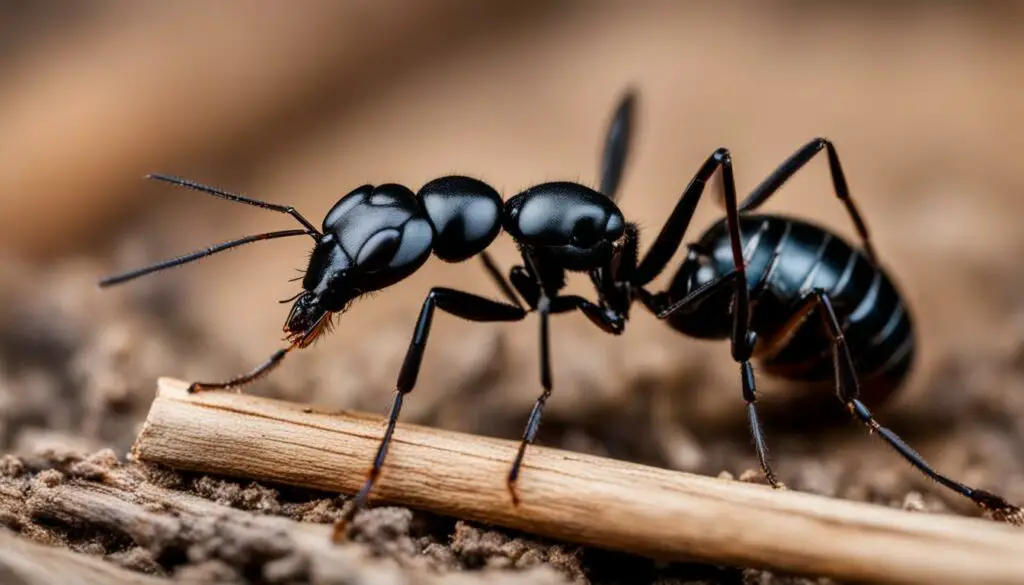
Carpenter Ant Pet Care Challenges
When it comes to caring for Carpenter ants as pets, there are a few challenges that owners may encounter. One of the main challenges is the potential for painful bites. Carpenter ants have strong mandibles and are capable of inflicting a painful bite if they feel threatened or provoked. As a pet owner, it is important to handle Carpenter ants with care and take precautions to avoid getting bitten.
Another challenge in Carpenter ant pet care is the level of commitment and attention required. Unlike some other types of pets, Carpenter ants require regular monitoring, cleaning, and feeding. They thrive in a specific environment and have specific dietary needs that must be met. As a pet owner, it is important to provide the necessary care and attention to ensure the health and wellbeing of your Carpenter ant colony.
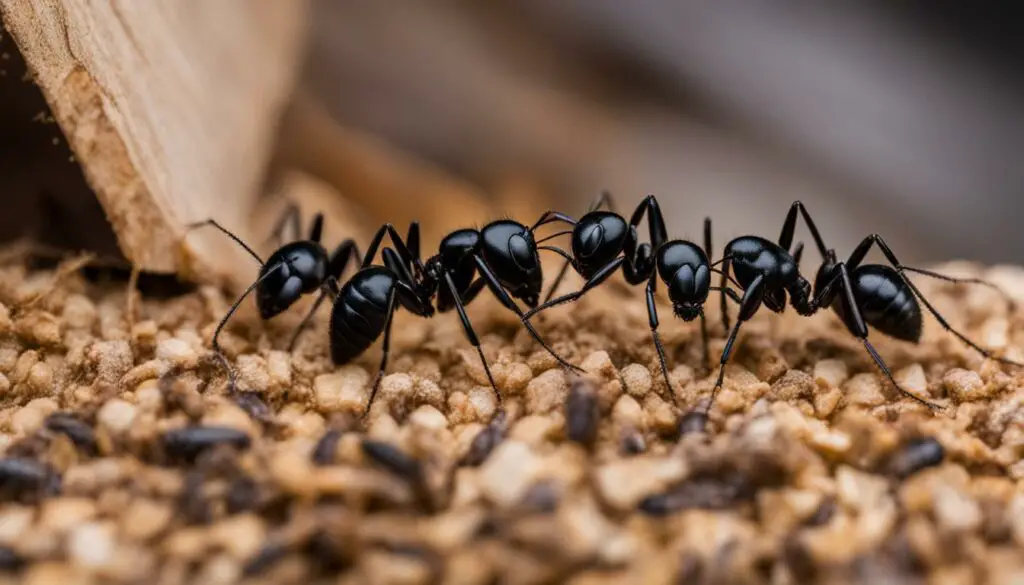
Common Misconceptions About Carpenter Ants as Pets
Keeping Carpenter ants as pets is an intriguing endeavor that requires commitment and care. However, there are several common misconceptions surrounding these fascinating creatures. One such misconception is that Carpenter ants are easy to care for and require minimal attention. In reality, Carpenter ants have specific needs and must be provided with proper care to ensure their health and well-being.
Another misconception is that Carpenter ants can thrive in any type of enclosure without specific environmental conditions. This is far from the truth. To promote the overall health of your Carpenter ant colony, it is crucial to create a suitable habitat that closely mimics their natural environment. This includes providing a combination of dry and moist areas, as well as natural materials for tunneling and nesting.
“It is essential to debunk these misconceptions and educate prospective Carpenter ant owners about the necessary commitment and care required for their well-being.” – Carpenter Ant Enthusiast
Understanding and addressing these misconceptions are vital in ensuring the proper care of Carpenter ants as pets. By providing accurate information and dispelling these myths, potential owners can make informed decisions and provide optimal care for their beloved Carpenter ant colonies.
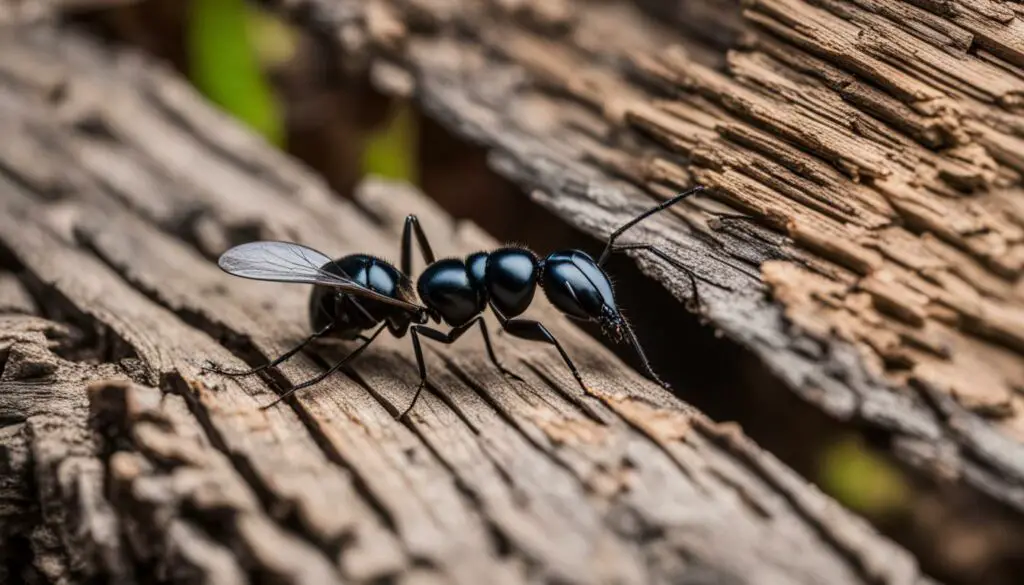
Table: Common Misconceptions About Carpenter Ants as Pets
| Misconception | Reality |
|---|---|
| Carpenter ants are easy to care for and require minimal attention. | Carpenter ants have specific needs and require commitment and care for their well-being. |
| Carpenter ants can thrive in any type of enclosure without specific environmental conditions. | Carpenter ants require a suitable habitat that mimics their natural environment for optimal health. |
| It is essential to debunk these misconceptions and educate prospective Carpenter ant owners about the necessary commitment and care required for their well-being. | |
Carpenter Ant Pet Supplies and Resources
When it comes to caring for Carpenter ants as pets, having the right supplies is essential. Here are some key items you will need to ensure the well-being of your ant colony:
Enclosure:
An enclosure that mimics the natural habitat of Carpenter ants is crucial. A glass or plastic terrarium with ventilation holes will provide the necessary airflow and visibility. Make sure the enclosure is escape-proof to prevent your ants from venturing into your home.
Substrate and Nesting Materials:
Creating a suitable environment for your Carpenter ants involves providing them with a substrate. Opt for soil or sand that can hold moisture and maintain humidity levels. Additionally, offer natural materials like wood and leaves for tunneling and nesting purposes.
Food Dishes and Water Source:
It is important to provide designated food dishes to offer a balanced diet to your Carpenter ants. Separate dishes for protein-based foods like insects and fruits, as well as sugary liquids such as honey or sugar water, will ensure proper nutrition. Additionally, ensure a consistent water source for your ants, such as a water gel or water dispenser, to fulfill their hydration needs.
Cleaning Supplies:
To maintain a clean and healthy environment for your Carpenter ant colony, regular cleaning is necessary. Keep a small brush or tweezers handy to remove any debris or uneaten food. This will prevent mold growth and the accumulation of waste that can harm your ants.
“Proper supplies and resources are the foundation of successful Carpenter ant pet care.”
Remember, the quality and safety of the supplies you use are essential for the well-being of your Carpenter ants. Consult reputable sources and expert advice when choosing and purchasing Carpenter ant pet supplies to ensure they meet the specific needs of your ants.
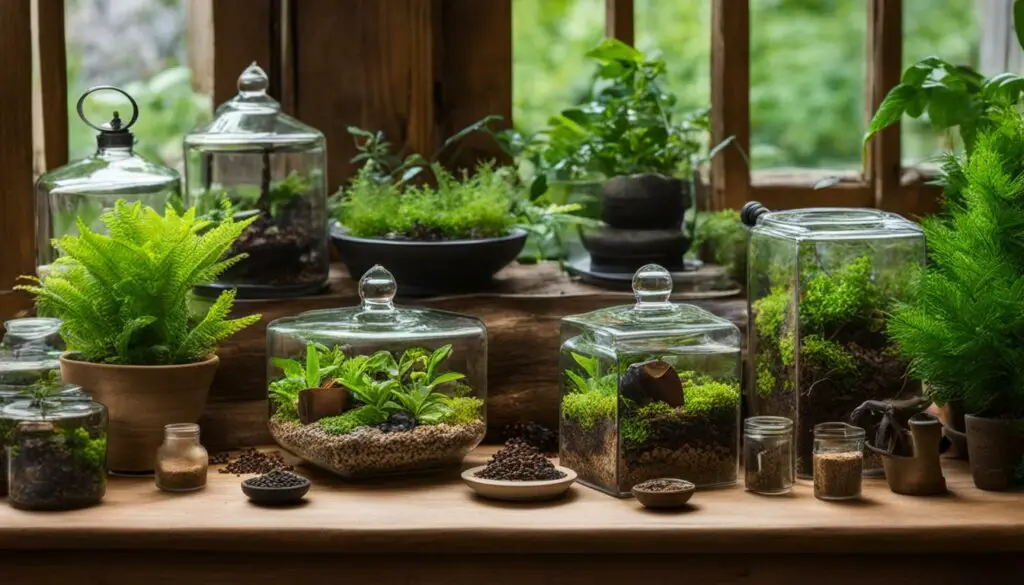
Tips for Finding and Acquiring Carpenter Ants as Pets
Acquiring Carpenter ants as pets can be a unique and rewarding experience, but finding a reliable source for these ants may pose a challenge. Here are some tips to help you locate and acquire Carpenter ants for your pet collection:
- Consult with local entomology organizations: Reach out to local entomology enthusiasts and organizations in your area. They may have contacts or knowledge about reputable sources for acquiring Carpenter ants as pets.
- Join bug enthusiast forums and communities: Online communities dedicated to bug enthusiasts can be a valuable resource for finding reliable sources. Engage with fellow members, ask for recommendations, and share your interest in acquiring Carpenter ants as pets.
- Research legal requirements: Before acquiring Carpenter ants, it is essential to research and comply with any legal requirements or permits necessary in your area. Some jurisdictions may have specific regulations regarding the keeping of Carpenter ants as pets.
- Check with exotic pet suppliers: While Carpenter ants may not be commonly found in pet stores, some exotic pet suppliers may specialize in providing a variety of insect species. Reach out to these suppliers to inquire about the availability of Carpenter ants.
Remember that acquiring Carpenter ants from the wild is not recommended, as it can negatively impact native populations and ecosystems. Always ensure that any Carpenter ants you acquire are obtained legally and ethically. By following these tips and relying on reputable sources, you can find and acquire Carpenter ants responsibly to start your own pet colony.

Table: Sources for Acquiring Carpenter Ants as Pets
| Source | Specialty | Contact Information |
|---|---|---|
| Local entomology organizations | Knowledge and contacts | Visit their websites or reach out via email |
| Bug enthusiast forums | Online community | Create an account and engage with members |
| Exotic pet suppliers | Specialize in insects | Check their websites or contact them directly |
Note: It is essential to verify the legality and ethical sourcing of Carpenter ants from any supplier or source.
Conclusion
In conclusion, mastering Carpenter ant pet care requires a solid understanding of their behavior, habitat, diet, and proper enclosure setup. By providing the ideal environment and fulfilling their nutritional needs, you can ensure the health and wellbeing of your Carpenter ant colony.
It is important to monitor their behavior and activity levels, maintain a clean enclosure, and regularly offer a balanced diet to promote their overall health. Additionally, understanding their complex reproductive system and hierarchical social structure is crucial for providing appropriate care.
While keeping Carpenter ants as pets can be rewarding, it is important to be aware of the potential challenges and responsibilities that come with it. Proper handling and attention to their needs, as well as adhering to any legal requirements, are essential.
With the right knowledge, commitment, and care, you can successfully care for Carpenter ants as pets and enjoy the fascinating world of these incredible insects.
FAQ
What do Carpenter ants eat?
Carpenter ants are primarily omnivorous and feed on a variety of foods, including insects, fruits, and sweets.
How do I provide a suitable habitat for Carpenter ants?
To create a suitable habitat for Carpenter ants, you will need an enclosure that mimics their natural environment, with a combination of dry and moist areas. Provide a substrate of soil or sand, along with natural materials like wood and leaves for tunneling and nesting.
What should I feed my Carpenter ants?
You can feed Carpenter ants a mix of insects, fruits, and sugary liquids such as honey or sugar water. It is important to provide a balanced diet to meet their nutritional needs.
What supplies do I need for a Carpenter ant enclosure setup?
You will need a suitable enclosure, substrate (such as soil or sand), natural materials for nesting (such as wood or leaves), food dishes, water source (such as a water gel or water dispenser), and cleaning supplies (such as a small brush or tweezers).
How do I keep my Carpenter ant colony healthy?
To keep your Carpenter ant colony healthy, monitor their behavior and activity levels, maintain a clean enclosure, provide a balanced diet, and ensure proper temperature and humidity levels. Regularly check for signs of illness or infestation and consult a veterinarian or entomologist if needed.
How do Carpenter ants reproduce?
Carpenter ants have a queen ant that lays eggs and starts new colonies. The queen mates with male ants during a mating flight, sheds her wings, and establishes a new nest.
How do Carpenter ants communicate?
Carpenter ants communicate through pheromones and touch. They leave scent trails to guide other ants to food sources and have a hierarchical social structure with the queen at the top.
How long do Carpenter ants live?
Worker Carpenter ants generally live for several months to a year, while the queen can live for several years.
What are some potential challenges in Carpenter ant pet care?
Some potential challenges include their ability to inflict painful bites, the need for regular monitoring and care, and the requirement for legal permits or approval in some areas.
What are common misconceptions about Carpenter ants as pets?
Common misconceptions include that they are easy to care for and require little attention, and that they can be kept in any type of enclosure without specific environmental conditions.
What supplies do I need for caring for Carpenter ants as pets?
You will need a suitable enclosure, substrate, natural materials for nesting, food dishes, water source, cleaning supplies, and a temperature and humidity monitor.
How do I find and acquire Carpenter ants as pets?
It is recommended to consult with local entomology organizations or bug enthusiasts for assistance in finding a reliable source. Ensure they are legally obtained and research the specific species to ensure compatibility with your care setup.

